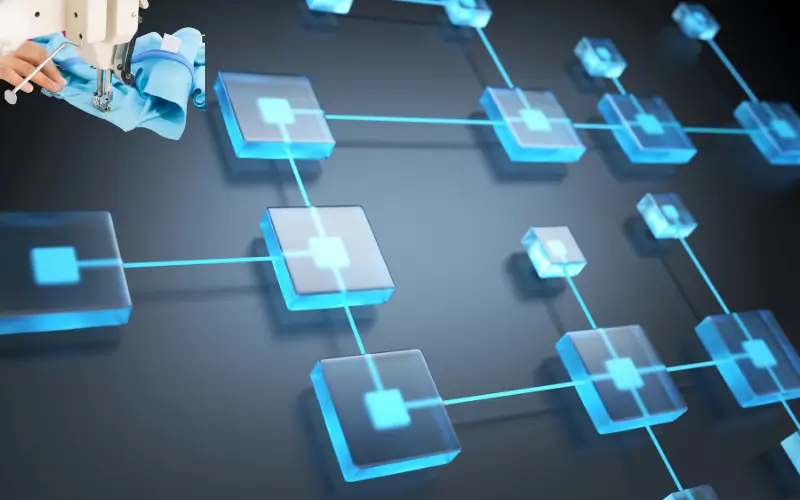Ever wondered what truly keeps a bustling garment factory running like a well-oiled machine? It’s the meticulous work of the maintenance department. Divided into specialized teams for Electrical and Utility Maintenance and Mechanical Maintenance, these experts are the unsung heroes. But even with their dedication, traditional methods often hit snags. This is where blockchain technology steps in – not as a mere upgrade, but as a profound transformation, ushering in unprecedented transparency, data integrity, and operational agility.
Blockchain’s Impact on Bangladesh’s RMG
The Old Way: Why Your RMG Maintenance Needs a Digital Overhaul
Let’s be honest, while current maintenance practices get the job done, they often come with inherent limitations. Consider these common pain points:
- Data Silos & Trust Deficits: Imagine maintenance logs, repair histories, and spare parts inventories scattered across various spreadsheets, paper files, or disconnected software. This fragmentation makes verifying authenticity a nightmare, hindering crucial root cause analysis, warranty claims, and compliance audits.
- Clunky Workflows: Manual processes for creating, assigning, and tracking maintenance tasks can lead to frustrating delays, miscommunication, and a glaring lack of real-time visibility. This directly impacts production schedules and overall efficiency.
- Spare Parts Headaches: Inaccurate inventory counts, difficulty tracing component origins, and opaque procurement practices often result in costly stockouts, unnecessary overstocking, and challenges in verifying part authenticity.
- Fuzzy Performance Metrics: Relying on manual logging for machine downtime and repair details is prone to human error. This leads to unreliable data for critical performance indicators like Mean Time Between Failures (MTBF) or Overall Equipment Effectiveness (OEE), making strategic improvements difficult.
- Compliance & Accountability Gaps: Ensuring strict adherence to maintenance schedules and safety protocols, and objectively assessing technician performance, becomes a constant uphill battle without an immutable, easily auditable record.
Blockchain: The Strategic Advantage for Modern RMG Maintenance
So, why blockchain? It’s far more than just a buzzword; it’s a foundational shift in how information is managed and trusted. For RMG maintenance, it delivers:
- Unshakeable Records: Picture every maintenance log, work order, and parts transaction permanently etched into a digital ledger – impossible to alter. This immutability builds inherent trust into every data point.
- Crystal-Clear Visibility: Authorized personnel gain real-time access to a shared, verifiable record of all maintenance activities. This fosters a culture of transparency and accountability, empowering smarter, faster decisions.
- Effortless Traceability: The ability to track the complete lifecycle of an asset, a repair, or a spare part, from its origin to its current status, provides an unparalleled, comprehensive audit trail.
- Intelligent Automation (Smart Contracts): These self-executing digital agreements automate workflows, enforce predefined rules (think automated PM schedules or safety checks), and trigger actions (like parts reorders or technician alerts), streamlining operations with precision.
- Built-in Resilience: By distributing data across a secure network, the system becomes inherently more robust, less susceptible to single points of failure, and highly resistant to data manipulation.
The Blueprint: How Blockchain Elevates Every Maintenance Function
Let’s dive into the specifics, exploring how blockchain seamlessly integrates into the core responsibilities of both Electrical & Utility and Mechanical Maintenance. We’re envisioning a hybrid blockchain model – a private chain for sensitive internal operations, with selective public integration for external verification.
Core Blockchain Enablers – The Foundation for All Maintenance:
- Digital Twins for Every Asset: Imagine every machine, every boiler, every critical tool having its own unique, immutable digital identity on your private blockchain. This “digital twin” becomes the central hub for its entire lifecycle data, from purchase to every maintenance event. Physical assets are easily linked via QR codes or RFID tags.
- Smart Contracts: These are your digital rule-enforcers, automating PM scheduling, work order assignments, parts reordering, and ensuring compliance with predefined protocols.
- IoT Sensor Integration: Real-time data from machine sensors (vibration, temperature) and utility systems (power consumption, pressure) can feed directly into the blockchain, triggering smart contract actions for proactive maintenance.
- Intuitive Mobile Interfaces: Empowering your technicians to log data, update work orders, and access vital information directly from the factory floor, boosting efficiency and accuracy.
I. Electrical and Utility Maintenance: Powering Reliability with Blockchain
This team is the factory’s lifeblood, ensuring electricity, steam, and air flow without interruption. Blockchain supercharges each of their vital functions:
- Maintaining Preventive and Planned Maintenance:
- Blockchain’s Edge: Smart contracts are pre-programmed with detailed PM schedules for all electrical systems (panels, wiring, motors) and utility equipment (boilers, air compressors). These contracts automatically generate work orders when due. Technicians then log every PM activity, reading (e.g., voltage, pressure), and finding directly onto the private blockchain. This creates an immutable, verifiable history, crucial for compliance and extending asset lifespan.
- Operating and Maintaining the Central Power Supply Station:
- Blockchain’s Edge: IoT sensors continuously monitor critical parameters like power consumption and generator performance. This real-time data is securely logged onto the private blockchain. Smart contracts are configured to trigger immediate alerts for any anomalies (e.g., power surges, low fuel), enabling rapid, proactive intervention. All operational adjustments and routine checks are meticulously recorded, providing a transparent, unalterable log.
- Stream and Air Line Making and Servicing:
- Blockchain’s Edge: Details of new line installations (materials, date, technician) and all servicing activities (e.g., leak repairs, pressure testing) are recorded on the private blockchain, linked to specific sections of the utility network. Smart contracts can even verify adherence to safety standards and ensure proper test results are logged before sign-off.
- Repairing and Maintaining Machines and Parts (Electrical Focus):
- Blockchain’s Edge: When electrical components (motors, sensors, control boards) are repaired or replaced on any machine, their details, along with the technician, date, and specific machine ID, are logged against the machine’s digital twin on the private blockchain. This builds a comprehensive, traceable history of electrical repairs, aiding future diagnostics and ensuring genuine parts usage.
- New Electrical Line Making and Wiring:
- Blockchain’s Edge: All aspects of new electrical wiring projects are meticulously documented on the private blockchain, including blueprints, material specifications, installation dates, and inspection results. Digital sign-offs from certified electricians and safety officers are recorded as immutable transactions, ensuring strict adherence to electrical codes and safety regulations.
II. Mechanical Maintenance: Ensuring Machine Longevity with Blockchain
This team is dedicated to the operational health of your production machinery. Blockchain empowers their functions with granular, verifiable data:
- Maintaining Preventive and Planned Maintenance:
- Blockchain’s Edge: Similar to electrical, smart contracts automate PM schedules for all mechanical machines (sewing machines, cutting machines, presses) based on usage hours or production cycles. Technicians log detailed PM activities, readings (e.g., lubrication levels, tension checks), and findings directly onto the private blockchain. This creates an immutable, easily auditable PM history for each machine, extending asset life and optimizing performance.
- Performing Daily Repairs and Maintenance:
- Blockchain’s Edge: Technicians log routine checks and minor adjustments on the private blockchain, linked to specific machine IDs. This builds a granular record of machine health and minor interventions, allowing for early identification of recurring issues.
- Identifying Problems and Troubleshooting:
- Blockchain’s Edge: When a problem is identified, technicians log detailed descriptions, symptoms, and troubleshooting steps taken on the private blockchain. This data contributes to a blockchain-linked knowledge base, allowing future technicians to access successful troubleshooting pathways. The immutable record of fault diagnosis aids in accurate root cause analysis and reduces repeat failures.
- Arranging and Adjusting Machines:
- Blockchain’s Edge: Specific machine adjustments (e.g., stitch length, tension, cutting parameters) are logged on the private blockchain, linked to the machine and potentially the specific production order. This helps in replicating optimal settings for different fabrics or styles and allows for correlation of adjustments with production quality and efficiency metrics.
- Responding to Breakdown and Repair Machines:
- Blockchain’s Edge: When a machine breaks down, production staff can initiate a work order via a mobile interface, immediately recorded on the private blockchain. Technicians update the work order with real-time progress, parts used, and estimated completion time. The blockchain provides an immutable history of the machine’s performance, previous repairs, and PMs, facilitating accurate root cause analysis. Crucially, verifiable logging of machine downtime for each breakdown is automatically captured, providing precise data for OEE calculations.
Why Blockchain is Essential for RMG Maintenance – The Transformative Payoff
Implementing blockchain across these specific maintenance functions isn’t just an upgrade; it’s a strategic imperative, yielding profound advantages:
- Unassailable Data Integrity: Say goodbye to data manipulation. All maintenance records – electrical, utility, and mechanical – are accurate, verifiable, and trustworthy for internal use and external audits.
- Optimized Operational Efficiency: Automate work order creation, assignment, and tracking, significantly reducing manual effort, communication delays, and response times across both maintenance teams.
- Intelligent Spare Parts Management: Achieve real-time, accurate inventory for all types of parts, enable automated reordering via smart contracts, and ensure verifiable authenticity, leading to reduced costs and minimized stockouts.
- Maximized Asset Uptime: Proactive, data-driven PMs, coupled with efficient repair processes and real-time utility monitoring, lead to fewer unexpected breakdowns and extended lifespans for all factory assets.
- Enhanced Accountability & Performance: Gain clear, immutable records of technician activities, work order completion, and parts usage, fostering a culture of accountability and enabling objective performance assessment for both electrical and mechanical teams.
- Significant Cost Reduction: Realize substantial savings through minimized downtime, optimized inventory, efficient resource allocation, and extended asset life cycles.
- Streamlined Compliance & Auditing: Enjoy an easily auditable, immutable trail for regulatory requirements, safety standards, and quality certifications (e.g., ISO 9001, ISO 14001), simplifying the entire audit process.
- Predictive Maintenance Capabilities: Leverage IoT sensor integration to shift from reactive to predictive maintenance for both machines and utility systems, preventing issues before they impact production.
- Data-Driven Decision Making: Empower maintenance managers with comprehensive, verifiable data to make informed strategic decisions regarding asset investment, technician training, and process optimization.
Key Considerations for Implementation
While the benefits are compelling, a successful blockchain implementation requires thoughtful planning:
- Initial Investment: Be prepared for the upfront capital required for blockchain infrastructure, IoT sensors, and comprehensive training programs.
- Seamless Integration: Prioritize seamless integration with your existing Enterprise Resource Planning (ERP) and Computerized Maintenance Management System (CMMS) software to avoid creating new data silos.
- Data Management: Develop robust strategies for handling the potentially vast volume of data generated by IoT sensors and detailed maintenance logs, potentially utilizing off-chain storage for raw data.
- Workforce Training: Invest in thorough training for all maintenance personnel – electrical, utility, and mechanical – to ensure comfort and proficiency with the new digital tools and processes.
- Standardization: While internal standardization is achievable, advocating for industry-wide standards for machine data and utility parameters would further enhance interoperability and benchmarking.
- Cybersecurity: Implement stringent cybersecurity measures for all interfaces and access points to the blockchain system, complementing its inherent security.
The Future of RMG Maintenance is Blockchain-Powered
By meticulously integrating blockchain technology into the distinct functions of both Electrical & Utility and Mechanical Maintenance, RMG factories can transcend traditional operational limitations. This strategic adoption creates an unparalleled ecosystem of immutable, transparent, and traceable maintenance records, leading to enhanced efficiency, reduced costs, and superior asset performance. It’s not just about fixing machines; it’s about building a resilient, intelligent, and future-ready manufacturing operation that sets new benchmarks for operational excellence in the global RMG industry.
Author: Salauddin Ahamed Sagar



